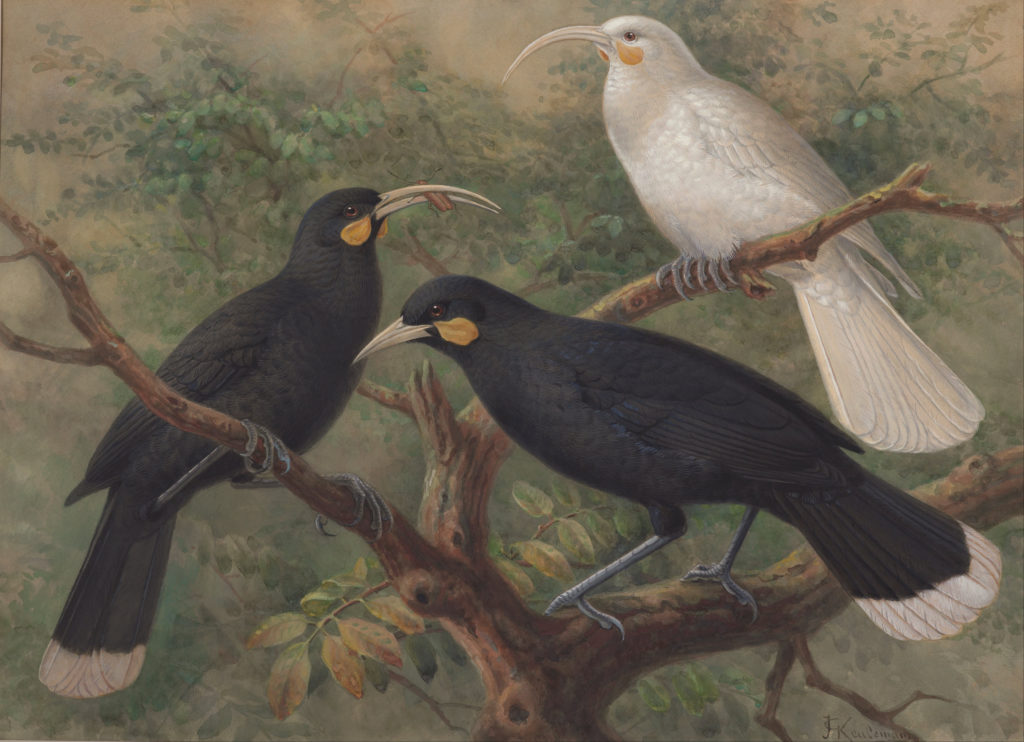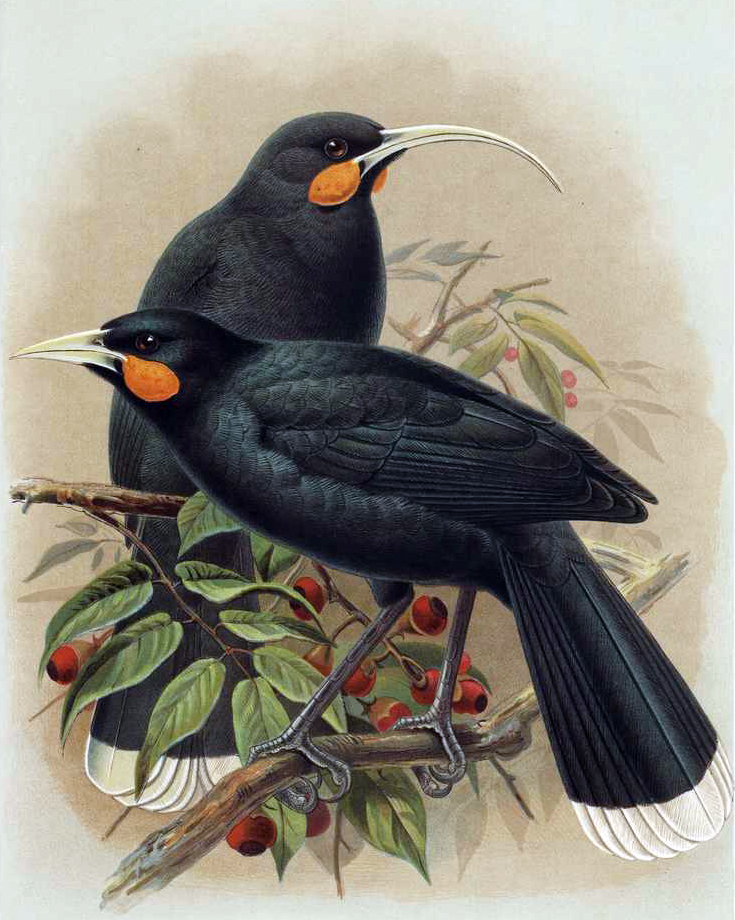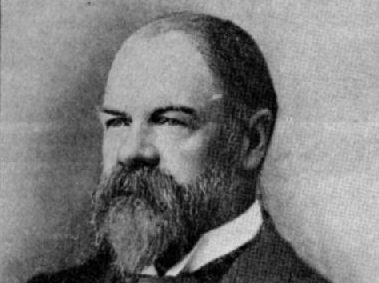How much would you pay for a feather? In 2024 a single huia tail feather sold at auction for NZ$46,521 – making it the world’s most expensive feather ever.

This article was updated in 2024 to reflect the most recent auction of a huia tail feather.
The popularity of the huia’s bold black and white tail feathers was a key part of its downfall. It was an avian victim of fashion, with avid collectors helping to drive it to extinction. Habitat destruction and introduced predators had an impact as well.
But there was much more to the huia than a bold stripe to its 12 long tail feathers.
The huia was a songbird about the size of a magpie – the largest of our wattlebirds and a relative of the tīeke (saddleback) and kōkako. Its head and body feathers were black with a glossy green-blue metallic sheen. It had orange wattles that grew from the base of the bill, and long strong legs which helped it hop, jump and bound about the forest. In contrast to its champion leaping ability, it was a weak flier, with short, rounded wings, much like the kōkako.

But most striking of all was its beak – or at least beaks – because the bills of males and females were very different in both size and shape. Males had a robust pale ivory tapering bill shaded bluish-grey at the base while females had a longer, finer decurved bill. The female’s bill was 85-104 mm long; the male’s heavier, less-curved bill was 54-60 mm.
Huia mainly consumed wood-dwelling insects and their larvae, including huhu, wētā, mantis, butterfly, also spiders, taken from decaying wood, bark, lichen, moss, ferns and the ground. They also ate native forest fruits, including hinau, pigeonwood, Coprosma, and kahikatea. They used their beaks to feed in different ways. Male huia used their bills as a “pick-axe” to dig into decaying wood, exposing and extracting huhu larvae and other insects. Females probed deeper using their longer, more decurved bill to extract larvae from more solid wood. One theory for the difference in bill shapes is that chicks were mainly fed by the female who used her bill to reach high-protein nutritious larvae for her young.
So marked was the difference in bills, that in 1936 ornithologist John Gould described male and female as two different species. The huia had the most extreme sexual bill dimorphism of any known bird species. Sadly this made them of even greater interest to collectors.
Both Māori and Europeans valued and hunted the huia. The bird was regarded by Māori as tapu, and the wearing of its skin or feathers was reserved for people of high status. Māori attracted the huia by imitating its call and then captured it with a tari (a carved pole with a noose at the end) or snare, or killed it with clubs or long spears.
Although the huia lived only in the southern North Island, its tail feathers were valued highly and were exchanged among tribes for other valuable goods such as pounamu and shark teeth, or given as tokens of friendship and respect. The feathers reached the far north and the far south of New Zealand through trading and were stored in intricately carved boxes called waka huia, which were hung from the ceilings of chiefs’ houses. Dried huia heads were also worn as pendants called ngutu huia.
A captured huia would sometimes be kept in a small cage so that its tail feathers could be plucked as they grew to full size. The bird was also kept by Māori as a pet, and like the tui, it could be trained to say a few words.
Māori were also the first to try and save the huia from extinction. There were successive sharp declines in numbers of huia in the 1860s and in the late 1880s, prompting the chiefs of the Manawatu and the Wairarapa to place a rāhui on the Tararua Range. In February 1892, the Wild Birds Protection Act was amended to include the huia, making it illegal to kill the bird, but enforcement was not taken seriously.

Tail feathers became fashionable in Britain after the Duke of York was photographed wearing one during a 1901 visit to New Zealand. At an official Māori welcome in Rotorua, a guide took a huia tail feather from her hair and placed it in the band of the Duke’s hat as a token of respect. And so a new fashion trend was launched in both England and New Zealand. The price of tail feathers was soon pushed to £1, making each bird worth £12 (12 feathers per tail), and some feathers sold for as much as £5. Female huia beaks were also set in gold as jewellery.
Shooting season notices ceased listing the huia as a protected species in 1901 – so much for the 1892 Wild Birds Protection Act – and a last-ditch attempt to reinforce government protection failed when the solicitor general ruled that there was no law to protect feathers.
Overseas bird collectors and museums bought mounted specimens and tail feathers. Austrian naturalist Andreas Reischek took 212 pairs between 1877 and 1889. New Zealand naturalist Walter Buller recorded that 11 Maori hunters took 646 huia skins from forest between Manawatu Gorge and Akitio during one month in 1863. Gilbert Mair recorded eating “a splendid stew of Huia, Kaka, Pigeons & Bacon” with Buller at a bush camp in Wairarapa, October 1883, after shooting 16 huia and capturing live birds.

Thousands of huia were exported overseas and plans to move birds to sanctuary islands never eventuated. A pair captured in 1893 for transfer to Little Barrier was instead appropriated by Walter Buller, who bent the law to take them back to England as a present for Lord Rothschild, along with the last collected live pair of laughing owls.
The huia’s tale is a human-induced tragic one – but what do we know about the lives of the birds themselves? What have we lost?
Like the kōkako, the huia was a songbird extraordinaire, with a male and female having different calls. Huia were thought to pair for life and a pair would sing ‘duets’ to each other, alternating their calls. The melodious and flute-like calls could be heard up to 400 m away. If one bird was caught, its calls were used to lure in its mate, so that it was easily captured too.
Walter Buller once had a captive pair and wrote of their devotion to each other. When the male of was accidentally killed, the female “manifesting the utmost distress pined for her mate and died 10 days afterwards”. A Māori man in the 19th century recalled: “I was always told by my old people that a pair of huia lived on most affectionate terms … If the male died first, the female died soon after of grief”.
The huia was once common in the North Island, but absent from the South Island. Genetic studies suggest huia had “moderate to high” historical population of 34,000 to 89,000 birds; probably higher pre-human settlement. They were widespread but sparse after European settlement, in the eastern North Island from Huiarau south, with most records from the Ruahine, Tararua and Rimutaka ranges and northern Wairarapa, and also from the hills around Wellington.

Huia were officially considered extinct in 1907, but possible sightings continued even into the 1950s and early 1960s. The last official confirmed huia sighting was made on 28 December 1907 when W. W. Smith saw three birds in the forests of the Tararua Ranges. But further credible reports were made.
On 28 December 1922, a man familiar with the species reported seeing three huia in Gollans Valley behind York Bay (between Petone and Eastbourne on Wellington Harbour), an area of mixed beech and podocarp forest well within the bird’s former range. Sightings of the huia were also reported there in 1912 and 1913. The reports were never investigated.
The last credible reports of huia come from the forests of Te Urewera National Park, with one from near Mt Urutawa in 1952 and final sightings near Lake Waikareiti in 1961 and 1963. The possibility of a small huia population still surviving in the Urewera ranges has been proposed by some researchers but is considered highly unlikely.
No recent searches have been made. There was, however, a proposal to resurrect the huia by cloning DNA from museum specimens.
Students at Hastings Boys’ High School organised a conference in 1999 to consider cloning the huia, their school emblem. Ngāti Huia agreed in principle to support the endeavour, which would be carried out at the University of Otago, and a California-based Internet start-up volunteered $100,000 of funding. However, staff the Museum of New Zealand Te Papa Tongarewa, said that the complete huia genome could not be derived from museum skins because of the poor state of the DNA, and cloning was therefore unlikely to succeed.
One final twist in the extinction story of the huia, is that it wasn’t just the huia that became extinct. When the huia died, its parasites died out too – an invisible extinction unmarked and unmourned at the time. One of those parasites was only discovered in the 21st Century.
Rallicola extinctus, a species of parasitic louse, was only known to live on the huia, and apparently became extinct with its host, while in 2008, a new species of feather mite, Coraciacarus muellermotzfeldi, was described from dried corpses found in the feathers of a huia skin held by a European museum.
Read more about the huia: at NZ Birds Online and Wikipedia
Hear a (human) rendition of the male huia’s call.

